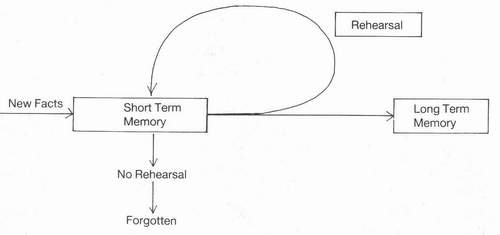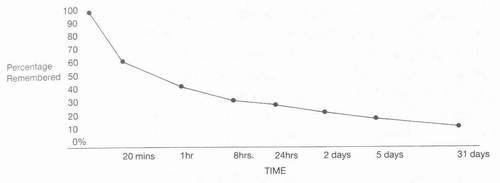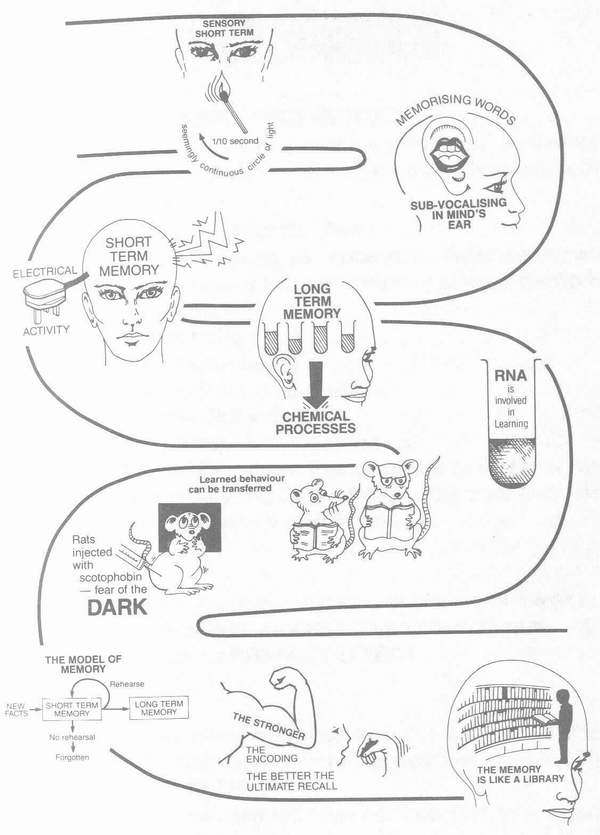
2. The Basis Of Memory
There is no learning without memory. From the primitive creature, who merely learns instinctive reflex behaviour through repeated exposure to a particular set of circumstances, to the Polish memorists who have memorised word for word all 12 volumes of the Talmud, learning involves memory. Yet surprisingly there is not yet an agreement as to how memory really works.
This book is about the evolution of an advanced and accelerated learning method, not a detailed text book on psychology. Nevertheless it is important that you are familiar with the latest conclusions on memory from clinical psychology.
More than one Memory
Most psychologists now agree that there are at least two memories: short term memory and long term memory. The short term memory, as Dr. Alan Baddeley describes it, seems to be the working memory.
If you want to multiply 28 x 3 in your head, you would use the short term memory to do the calculation, and then, if it were significant enough, commit the answer to your long term memory. The short-term memory is, effectively, a temporary storage device.
When you are reading a sentence, it is your short term memory that retains the words at the beginning of the sentence for long -enough to make sense of the whole sentence. Then it is the meaning, rather than the individual words, that is transferred into your long term memory. The long term memory is the permanent storage system from which recall can be made.
The short term memory seems to analyse, the long term memory seems to synthesise. Interestingly, the design work that has gone into producing computers has recognised this distinction.
A computer is divided into a working memory - the Random Access Memory (RAM), which is the processing and calculating part, and a storage memory called the Read Only Memory (ROM). If you switch off the computer the RAM contents disappear, just as those of the short term memory seem to. They must be recorded onto a disc or tape (or incorporated into the form of a permanent ROM chip) if they are to be stored permanently.
How Short is Short?
There have been some interesting experiments designed to estimate the time span of the short term memory. If you take a glowing stick from a bonfire and rotate it fast enough in the dark, it will appear to produce a full circle of light. This is because the sensory memory - a specialist part of your short term memory - retains the image of the light long enough for the actual light to return back to its starting point on the circle.
In the same way, a cinema film is a series of still pictures with very short periods of darkness in between. In order to see the film as continuous action, you need to hold the image of the last frame ; in your short term memory until the appearance of the next frame, and relate them together in such a way as to produce an impression of continuous movement.
The time span of this type of sensory short term memory is probably about 1 /10 of a second.
The time span of the short term memory acting as a working memory - to calculate or to read - is a matter of some discussion. Baddeley conducted experiments on the way words were memorised. He found that a series of long words was less well recalled than a series of short words, probably because the subjects, in order to remember the list, were sub-vocalising the words, i.e. hearing the words in their `mind's ear'.
Clearly the longer the words, the longer it took to sub-vocalise them, and the subjects could only remember as much as they could say in 15 seconds. As would be predicted by the theory, fast talkers could remember more!
Researchers Waugh and Norman, writing in `The Psychological Review' in 1965, confirmed that the number of unrelated numbers a person can recall after just one presentation rarely exceeds 10 - about the same number that could be spoken or heard in your mind's ear in 15 seconds.
They also identified an auditory and visual short term memory, and commented that reading aloud was helpful since it helped to register (encode) the material in the short term auditory store as well as the short term visual store.
This point is important, because other researchers have found that the process of rehearsal involved in the sub-vocalisation, is critical to transferring information from the short to the long term memory. Unless an item is rehearsed, it is lost out of the short term memory, and does not enter the long term memory.
Other researchers also calculate a short term memory of about 15 seconds in span. Carroll (1966) deduces this from the work of simultaneous translators, who have to hold a sentence or sentences in their short term memory and translate with only the briefest of delays. The same indication (of a 15 second span) is implicit in the ability of court reporters to hold 10-15 second's worth of evidence before transcription.
Electrical v Chemical
No-one knows exactly how memory is created in the physical sense. But a recent series of experiments indicate that short term memory involves a primarily electrical activity in the brain, and long term memory involves a predominantly chemical process, and the possible modification of proteins.
Researchers Flood and Jarvik have reported that drugs which affect the synthesis of proteins, or their transfer along the axons, only affect long term memory, whereas drugs, that affect electrical activity in the brain appear only to affect short term memory. Other experiments support the view that long term memory involves chemical changes. Thus researcher J.V. McConnell began research in 1966 which showed that RNA (ribonucleic acid) was involved in learning, and that learned behaviour could be transferred from one rat to another by exchanging RNA from one brain to another.
In 1970 George Ungar at the Bayer College of Medicine, Houston, Texas taught a group of rats to be afraid of the dark. He then isolated a particular protein from the brains of those rats and injected it into the brains of untrained rats - who immediately showed the same fear of the dark! Subsequently he reproduced the protein artificially, (he named it Scotophobin, from the Greek for fear of the dark), and found that the artificial protein, when injected into normal rats, had the same effect. They too became frightened of the dark.
Since then, other researchers have found that Scotophobin when injected into goldfish teaches them to fear the dark; so the specific amino acid chain in this particular protein may have a universal significance.
Yet further teams of researchers have identified brain chemicals that discriminate between colours.
Scientists are already working on direct computer brain symbiosis (the direct linking of a human mind to a computer). It seems that we now have two futuristic avenues for research: artificial learning by electrical input (computer/brain links) and artificial learning by chemical input.
There seem to be parts of the day when learning is optimum usually later rather than earlier. This may also be due to the fact the body goes through a complex hormonal and chemical cycle throughout the day, and this cycle may well be influential on the production of the chemicals which result in the consolidation of memory traces.
When we talk of memory in future pages we shall mean long term memory.
Memory as a Three Way Activity
We talk loosely about memory, but there are actually three distinct aspects to memorising something. The three 'R's' of memory, are Registration, Retention and Recall. You have to: (1) Become aware of new facts and make an active effort to transfer them to long term memory. That is Registration or as psychologists term it `encoding'.
(2) Store these facts in your long term memory and (3) Be able to recall the facts when you need them.
Psychologists often refer to the "tip-of-the-tongue phenomenon" to illustrate the difference between recognition and recall. This is the common experience of feeling you know a name, for example, and perhaps even the initial letter of that name, yet are unable to recall it accurately and completely.
Clearly the memory is there, because you almost always recognise the name when it is eventually given - but cannot recall it fully without aid.
When faced with an apparently new learning task, it is sometimes difficult to comprehend just how fast our recall can be. If you are a fast talker, for example, you may speak at about 170190 words a minute and the words will be produced in correct grammatical order. It seems like a reflex action, but the mechanism clearly involves an astonishing display of logic manipulation (in the short term memory) and retrieval of the correct grammar and vocabulary (from the long term memory), coupled with a possible simultaneous use of right brain to conceptualise and left brain to speak forth the conclusions. Not for the first (or last) time in this book the mind may well marvel at its own complexity!
That the three activities of Registration, Retention and Recall are not necessarily the same is easily proved. Consider the following list of words and repeat them twice. (That's the encoding part).
Test No 1
Fox - Play
Place - Spy
Pen - Lamp
Tree - Full
Book - Sink
Far - Water
Easy - Grass
Bike - Sand
Now look away and write down as many words as possible. Then look back at the list. Do you `recognise' all the words? If you do, then clearly you remember them, in the sense that you acknowledge you have seen them before. So the memory was there, but it is unlikely that you will actually have recalled them all correctly. Potential memory is invariably greater than actual recall. Recall is not the same as recognition. It is incidentally, clear in testing old people that if their memory deteriorates at all, it is the ability to recall that declines, not the ability to create or store information.
The distinction between memory defined as recognition of facts or events when we are reminded or "given a clue" and memory defined as the ability to recall without a prompt is an important one. It is the reason why the accurate measurement of learning is quite difficult and why it is important to agree a definition of learning before hand.
Here is a suggestion. As you read through this book, note down any fact or conclusion, that you think would be important in creating the ideal learning programme.
You might, for example, have concluded that, without rehearsal of a new fact in the short term memory, it would not get transferred to the long term memory. You might also have concluded from Chapter One that, since your brain's potential capacity is so obviously enormous, the requirement of any learning system, is not that it should increase your intelligence but that it should .: release a fraction of the talent you already have. If you actively make notes, you will not only obtain much more benefit from this book - you will learn something fundamental about memory and about learning itself.
The Model of Memory

Numerous researches have conducted experiments which indicate that information which is not rehearsed in the short term memory is rapidly forgotten. Conversely, there seems to be a direct correlation between the amount of rehearsal and the probability that the material will be recalled. Murdoch and Waugh (1963) showed that the probability of recalling a word that had been listened to for 2 seconds was almost twice the probability of recalling a word that had been listened to for 1 second.
This is because the short term memory is the part of the memory that does the encoding, or registration, and the better the encoding the stronger the ultimate memory.
Memory as a Library
Your memory is very similar to a library. If that library had hundreds of thousands of books stored in it in a completely random manner, you will find it almost impossible to retrieve any one book. But if the books are stored systematically (by subject and by author for example), then retrieval becomes simple and quick.
Encoding is the equivalent of a library index. If you register each new piece of information strongly at the beginning, you will be able to retrieve (recall) it easily later. All psychologists are agreed that the better the encoding, or the more the associations, the better the retrieval.
So in evolving our Accelerated Learning system, our investigations have concentrated upon one key question - "What makes for strong encoding and for powerful associations?" Before we turn to that, however, let us look for enlightenment from the opposite question -
"Why do we forget?"
The Ebbinghaus Experiments
The pioneer in memory research was Hermann Ebbinghaus who conducted the first scientific experiments on memory in Germany between 1879 and 1885.
Since he realised that meaning and associations had a powerful effect on learning, he confined himself to learning lists of nonsense syllables such as WUX. CAZ, BIJ, ZOL.
He found that there seemed an almost straight line relationship between the initial time spent in learning and the amount learned. There seemed to be neither a law of diminishing returns, nor was there a snowball effect. The more time you spent on a list the more you apparently learned. He called it the Total Time Hypothesis. It seemed to support the theory on which teaching is based even to this day - that the way to learn is through grim determination and repetition. We now know that this is simplistic - and whilst time spent is certainly important, the way the time is spent and the way the information is presented, have an enormous effect on the rate of learning. In fact, Accelerated Learning is the way to break out of the Total Time Hypothesis.
One technique will illustrate the point. Psychologists call it the "the distribution of practice effect". This shows that the time taken to learn something is significantly less if the learning is spaced out. Thus a task taking 30 minutes, if learnt all in one day, will typically take 22 minutes if spaced over two days, an almost 30% saving.
In a similar way recall is enhanced if there is a short space between two presentations of the same material. Furthermore if you test yourself and succeed in recalling the correct answer, your i memory for those facts will be considerably strengthened compared with merely having the information given to you. Active involvement is always a more powerful memory enhancer than passive learning.
So a successful test is desirable. And clearly the sooner the test is conducted the higher the probability of the answer being correct.
The solution is to use the following learning strategy-which well accords to the short term/long term memory models.
Time scale

Thus you would learn (for example a new foreign word) and test (or rehearse) immediately, within the span of the short term memory. Then learn and rehearse the second item again within the Short Term Memory span. Then you would go back, after an interval, to the first item. You've achieved immediate rehearsal and also spaced practice.
The above however, has been somewhat of a digression since we are mainly interested in Ebbinghaus for his work on forgetting. Ebbinghaus found that forgetting could be plotted on a graph - known now as the Ebbinghaus Curve of Forgetting. The graph looks as follows:

Few people will be surprised at the result.
Common experience is that memory does not seem to decay over time, but that there comes a point at which little further deterioration is experienced.
But why?
There have been two basic theories. One is that memory traces gradually fade over time rather as the sun might bleach the colour in your curtains. The other theory is that it is the number of intervening new experiences that weaken the original memory trace, "crowding out" old memories. This is called the interference theory.
Fortunately, due to a number of elegant experiments, it now seems clear that interference is the primary reason for forgetting, rather than a simple decay over time. And the more similar the events (or facts) that intervened the more that was forgotten. We might call it the Confusion Factor.
Ebbing haus' experiments appeared to show that forgetting was an unfortunate fact of life. The more recent experiments, however, have explained the apparently inevitable memory decay as new competing experiences weakening the old memory traces. Now if that were true it would imply that the more you learnt (new) the more you would forget (old).
This is a popular misconception. Many people seem to think of memory as a water jug of limited capacity. Some of the old has to be poured out to make way for the new. As we shall see, however, the reverse is true. Your memory is more like a tree. The more branches on the tree, the greater the possibility for new branches to grow.
Ebbinghaus' experiments were designed in such a way as to produce the maximum degree of forgetting, because he deliberately eliminated everything that we have now come to recognise is vital in preserving memory. By using nonsense phrases he eliminated meaning, organisation and association, and thereby eliminated the most powerful positive factors in preventing forgetting. So his conclusions were only relevant in the most unpromising circumstances. In contrast we shall see that it is possible to create an ideal learning situation in which there is almost no forgetting.
Let us now turn from why we forget to the opposite question. What are the positive influences on memory?
